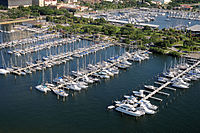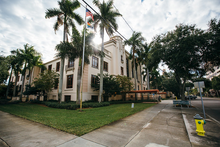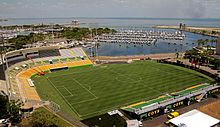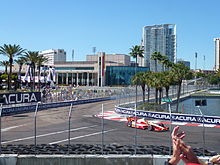Largest employers
According to the City of St. Petersburg, Florida's 2015
Comprehensive Annual Financial Report, the largest employers in the city are:
[105]
| # |
Employer |
# of Employees |
Industry |
| 1 |
Raymond James |
3,200 |
Investment |
| 2 |
Johns Hopkins All Children's Hospital |
3,200 |
Healthcare |
| 3 |
Home Shopping Network |
2,200 |
Retail |
| 4 |
Fidelity National Information Services |
1,900 |
Financial Sector |
| 5 |
Publix Super Markets |
1,900 |
Retail |
| 6 |
St. Anthony's Hospital |
1,800 |
Healthcare |
| 7 |
Bayfront Medical |
1,600 |
Healthcare |
| 8 |
Bright House Networks |
1,600 |
Communications |
| 9 |
Jabil Circuit |
1,500 |
Electronics Manufacturing Services |
| 10 |
Transamerica Life Insurance |
1,200 |
Insurance |
Arts and culture
The Grand Prix of St. Petersburg with the then named Progress Energy Field in 2012
Events
One of
the first of many major events of the year that takes place is the Dr.
Martin Luther King Jr. Parade, which is held in the month of January.
[106][107]
The parade hosts many bands facing off in a Battle of the Bands, Drum
Line Extravaganzas that has been duplicated throughout other cities.
[108] In March the city hosts the annual
Firestone Grand Prix of St. Petersburg. The annual Grand Prix is located in downtown St. Petersburg and is the first round of the
IndyCar Series.
[109] The downtown race usually lasts three days with practice rounds, qualifications, and two main races.
[110]
Bluesfest is the earliest event which is hosted in the Vinoy Park.
[111] Bluesfest hosts multiple live blues artists, views of the Tampa Bay waters from the park, and providing drinks and free food.
[112][113]
One of the many art festivals, called the Mainsail Art Festival, is
free entry art exhibition which takes place at the Vinoy Park, which
provides people quality art that they can purchase from local artists.
The art festival also provides live music, awards, and food courts.
[114][115] The triathlon event which takes place downtown is hosted by
St. Anthony's Hospital
which involves a 1.5k swim through Tampa Bay, a 40k bike along the
waterways, and a 10k run through the neighborhoods and onlooking
spectators.
[116][117]
One of the last major events is the Green Thumb Festival, a special
event originating in 1986 to promote tree beautification and planting in
the city of St. Petersburg which is currently located in Walter Fuller
Park.
[118][119]
A major event that takes place in June is the St. Pete Pride weekend. During this weekend, the
LGBT community
and supporters come to celebrate in the streets with festivals, 27/82
concert, LGBT pride parade, pride in fashion, and so much more.
[120][121]
The St. Pete Pride weekend also hosts a variety of block parties, food
stands, DJ stands, art festivals, local hosted parties, and the LGBT
welcoming center.
[122][123] In July, the 4th of July firework celebration invites the citizens to downtown St. Petersburg to watch the fireworks.
[124] In November, one of the last major music and food event hosted in St. Petersburg is the annual
Ribfest located at the Vinoy Park.
[125]
Ribfest hosts many festivities that include teams of award winning
"ribbers" and other "yummies", family fun zones, drinking vendors, and
two stages hosting many well known country music artists.
[126]
From the end of November through December begins holiday events.
During this time, the city has a tree lighting ceremony to start
celebrations. The first event of this holidays is the
Santa Parade followed by Snowfest with "
glice" skating, toboggan slides, Kiddyland, and other events.
[127]
Kids are able to meet Santa and ice skate in the North Straub Park.
North and South Straub park are decorated with holiday lights and
decorations while the Vinoy Park is decorated with large Greeting cards
created by the Recreational Centers in St. Petersburg.
[127] The city hosts an annual
NCAA football game in Tropicana Field entitled the
St. Petersburg Bowl every year in mid December.
[128]
On December 31, St. Petersburg has its last event called the First
Night St. Petersburg where people celebrate the arts from venues across
the city.
[129]
Around the year, the American Stage in the Park hosts many different shows at the Demens Landing Park.
[130][131] St. Petersburg has also hosted the
Miss Florida Pageant eleven consecutive years from 2004 to 2015 until it was moved to
Lakeland, Florida.
[132]
Tourism
The city has a children's museum (
Great Explorations), Museum of Fine Arts, and will soon host the
Museum of the American Arts and Crafts Movement (expected to open in 2017),
[133]
The St. Petersburg Museum of History (which has a full-size replica of
the Benoist XIV seaplane and is located near the approximate spot by the
St. Petersburg Pier where the first scheduled commercial flight
departed),
[134] a Holocaust Museum, and the Salvador Dalí Museum, which houses the largest collection of
Dalí's works outside of Europe, including a number of famous and large-scale paintings such as
The Discovery of America by Christopher Columbus.
[135] The
Chihuly Collection, located at 400 Beach Drive, houses some of the magnificent glass sculptures of
Dale Chihuly.
[136]
There are also various other smaller art galleries and entertainment
venues, especially in the downtown area, which has seen a boom in
development since the mid-1990s; these include the Mahaffey Theater
complex, American Stage (an equity regional theater), The Coliseum, and
Palladium Theatre, and the Midtown Royal Theater, The Arts Center, and
the Florida Craftsmen Gallery.
[137][138]
The St. Petersburg Pier was a popular tourist attraction, which is now closed since May 2013.
[139] The
Bounty, a replica of
HMS Bounty that was used in the
1962 Technicolor remake of Mutiny on the Bounty, starring
Marlon Brando, was permanently docked near the Pier for many years until the ship was sold to
Ted Turner in 1986.
[140] The
Bounty, however, sometimes visited St. Petersburg for the winter in the following years before its sinking in 2012.
[141] In 2010, the St. Petersburg City Council voted to demolish and rebuild the pier,
[142] which is set to open in 2018.
[143]
The city had a
Madame Tussaud Wax Museum between 1963 and 1989.
[144]
Downtown is the location of the
Sundial shopping complex which opened in May 2014.
[145] It contains an
IMAX Muvico
20-screen movie theater, as well as many chain restaurants and retail
shops, catering to more of a middle and upper class audience. The
Sundial St. Pete has nightlife destination, although it is less well
attended than the block surrounding Jannus Live, just south of Sundial
St. Pete. Central Avenue, from the Yacht Club west to 8th Street, is
also both more vibrant and "organic" the Sundial St. Pete with the
exception of a couple underdeveloped blocks. Restaurants serving ethnic
and domestic culinary specialties can be found throughout the downtown
area. Every Saturday morning, from October to May, the downtown area
hosts a
farmers' market
in the parking area of Al Lang Stadium (formerly Progress Energy Park).
Local vendors sell the fruits of their labors (whether edible or
decorative) alongside artists of all kinds including live music.
[146]
West of downtown on Central Avenue is the district known as 600 Block
Arts District. The district contains art from Bohemian origins and
clothing stores.
[147] The eve-N-odd gallery is located in the historic Crislip Arcade built in 1925.
[148]
The refurbished shopping arcade is one of 13 original city arcades
built in the city. Only three are left and only the Crislip arcade is
still being used as a place for small businesses to set up shop.
[149] Further west is the Grand Central District located within Historic Kenwood District. It is known for its artistic community,
LGBT presence, and hosting of the annual St. Pete Pride parade.
[150]
Haslam's Bookstore can also be found in the Grand Central District. It
is the largest independent bookstore in Florida with over 30,000 square
feet.
[151]
Like its name implies, Old Northeast is adjacent to downtown from the
northeast. It is known for its historic status and eclectic
architecture.
[152][153]
St. Petersburg boasts two historic neighborhoods: Roser Park, located
just south of the downtown area, and Grenada Terrace, in the Old
Northeast Neighborhood. Both are known for stately architecture and
together, comprise the urban core of St. Petersburg.
[154][155]
Williams Park with bandshell, one of the many public greenspaces in the area
North of downtown is the
Great Explorations Children's Museum,
an interactive museum featuring a Children's Village with giant pretend
stores, fire house and pet vet clinic, and preschool, science, music,
art, and water exhibits. The museum is located next to
Sunken Gardens.
[156]
4th Street as a whole, from Downtown up to Gandy Boulevard, is home to
many restaurants and bars running the gamut from fast food to
haute cuisine. This area is called the "Garden District", although as of 2010 this name is not widely in use.
[157]
Boyd Hill Nature Park, located on Lake Maggiore, is a 245-acre (0.99 km
2) preserve where one can see many of the endangered plants and rare wildlife of Tampa Bay.
[158] There is a bird exhibit which houses
bald eagles,
owls,
hawks, and other species.
[159]
St. Petersburg is well regarded for its beaches. In 2005,
Fort De Soto was rated the number one beach in America by the annual Dr. Beach rankings.
[160] TripAdvisor had the beach ranked number one in the nation for 2008.
[161] Also noted for its arts community, St. Petersburg regularly places top 25 in the nation among arts destinations.
[162] St. Petersburg has become known and regarded as one of America's most livable cities.
[16]
The area's main shopping mall is
Tyrone Square Mall, constructed in 1972 and is located in the northwestern part of the city.
[163]
Cinema
St. Petersburg has been used as a filming location for films over the years including
Once Upon a Time in America (1984),
Summer Rental (1985),
Cocoon (1985),
Ocean's Eleven (2001),
Loren Cass (2006),
Dolphin Tale (2011),
Magic Mike (2012),
Spring Breakers (2013), and
Dolphin Tale 2 (2014).
[164]
 Saint Petersburg, Russia[227]
Saint Petersburg, Russia[227] Figueres, Spain (since 2011)[228]
Figueres, Spain (since 2011)[228]












